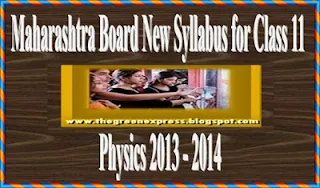
Maharashtra Board Syllabus for Class 11 Physics | MSBSHSE Syllabus 2013 - 2014
Get Maharashtra Board Syllabus for class 11 Now. Complete coverage of Syllabus - Maharashtra Board for class XI Excel , PDF in your exam with The Green Express.
Class 11
PHYSICS
( Syllabus)
Std. XI
Maharashtra Board Syllabus- 2013-14
1. Measurements:-
Introduction, Need for measurement, Units for measurement, System of Units,
S.I. Units, Fundamental and derived units, Dimensional analysis, Order of magnitude and
significant figures, Accuracy and errors in measurement.
2. Scalars and Vectors
Addition and subtraction of vectors, Product of vectors.
3. Projectile motion
Uniformly accelerated motion along straight line, Non uniform motion, Position time graph and
velocity-time graph, Equation of a projectile path, Time of flight, Horizontal range, Maximum
height of a projectile, Relative velocity.
4. Force
Types of forces, General idea of gravitation, electromagnetic and nuclear forces, Law of
conservation of momentum, Work done by a variable force. Work-energy theorem, Elastic and
inelastic collisions in one and two dimensions, Inertial and non-intertial frames, Moment of
force, Couple and properties of couple, Centre of mass, Centre of gravity, Conditions of
equilibrium of a rigid body.
5. Friction in solids and liquids
Origin and nature of frictional forces, Laws of static friction, Laws of kinetic friction, Pressure
due to fluid column, Pascal‟s Law and its applications, Effect of gravity on fluid pressure,
Viscosity, Streamline flow, Turbulent flow, Viscous force, Newton‟s formula, Stokes‟ law,
Equation for terminal velocity, Raynold‟s number, Bernoulli‟s principle and its applications.
6. Sound Waves
Waves and oscillations, Progressive waves, Characteristics of transverse waves, Characteristics
of longitudinal waves, Sound as longitudinal wave motion, Relation between v, f and, ƛ
Newton‟s formula for velocity of sound, Laplace‟s correction.
7. Thermal properties of matter
Temperature and heat, Measurement of temperature, Ideal-gas equation and absolute
temperature, Thermal expansion, Specific heat capacity, Calorimetry, Change of state, Latent
heat, Heat transfer.
8. Refraction of Light
Refraction of monochromatic light, Snell‟s law, Total internal reflection, Critical angle, Optical
fibre, Dispersion of light, Prism formula, Angular dispersion and dispersive power, Rainbow,
Scattering of light, Blue colour of sky, Colour of sun at sunrise and sunset. Elementary idea of
Raman effect.
9. Ray optics
Reflection of light by spherical mirrors, Refraction at single curved surface, Lens maker‟s
equation, Combination of thin lenses in contact, Concept of conjugate focii, Correction of eye
defects, Magnifying power of simple microscope, Magnifying power of compound microscope,
Magnifying power of telescope, Reflecting telescope - schematic diagram with explanation.
10. Electrostatics
Frictional electricity, Charges and their conservation, Coulomb‟s law and dielectric constant,
Forces between multiple electric charges, Superposition principle of forces, Continuous
distribution of charges, Concept of charge density, Electric field intensity, Potential energy,
Electric potential due to point charge, Relation between electric field intensity and potential,
Potential difference, Volt and electron volt, Electric dipole and dipole moment, Electric lines of
force. Equipotential surfaces, P.E. of single charge and system of charges.
11. Current electricity
Ohm‟s law, Resistance, Specific resistance, Temperature dependence of resistance, Colour code
of carbon resistor, Series and parallel combination of resistors, E.M.F. and internal resistance
of cell, Work done by electric current, Power in electric circuit, Cells in series and in parallel,
Elementary idea of secondary cells.
12. Magnetic effect of electric current
Oersted’s experiment, Biot Savart‟s law, Right hand rule, Magnetic induction at the centre of
circular coil carrying current, Magnetic induction at a point along the axis of a coil carrying
current, Fleming‟s left hand rule, Force between two infinitely long current carrying parallel
conductors, Definition of Ampere, Force acting on a conductor carrying current in magnetic
field, Torque on a current loop in magnetic field.
13. Magnetism
Origin of magnetism due to moving charges, Equivalence between magnetic dipole and circular
coil carrying current, Definition of magnetic dipole moment and its unit, Torque acting on a
magnet in uniform magnetic induction, Bar magnet as an equivalent solenoid, Magnetic field
lines, Magnetic induction due to bar magnet at a point along the axis and at a point along
equator, Earth‟s magnetic field and magnetic elements, Electromagnets and factors affecting
their strength.
14. Electromagnetic waves
Electromagnetic waves and their characteristics, Transverse nature of electromagnetic waves,
Electromagnetic spectrum, Space communication, Propagation of electromagnetic waves in
atmosphere.
Physics
List of Practicals
Std. XI
1. Use of Vernier Callipers.
2. Use of Screw gauge.
3. To determine radius of curvature of a given spherical surface by a spherometer.
4. To find the weight of a given body using parallelogram law of vectors.
5. To study the relationship between force of limiting friction and normal reaction and to find co-efficient of friction between a block and a horizontal surface.
6. To determine resistance per cm of a given wire by plotting a graph of potential difference versus current.
7. To find the value of „v‟ for different values of „u‟ in case of a „concave mirror and to find the focal length.
8. To find the focal length of a convex lens by plotting graphs between „u‟ and „v‟or between „1/u‟ and „1/v‟.
9. To find the focal length of a convex mirror, using a convex lens.
10. To find the focal length of a concave lens, using a convex lens.
11. To determine angle of minimum deviation for a given prism by plotting a graph between
angle of incidence and angle of deviation.
12. To determine refractive index of a glass using a travelling microscope.
13. To find refractive index of a liquid by using (i) concave mirror, (ii) convex lens and plane
mirror.
14. To determine specific heat capacity of a given (i) liquid (ii) solid, by method of mixtures.
Physics
List of Activities
Std. XI
1. To make a paper scale of given least count, e.g. 0.2 cm, 0.5 cm.
2. To determine mass of a given body using a meter scale by principle of moments.
3. To plot a graph for a given set of data, with proper choice of scales and error bars.
4. To measure the force of limiting friction for rolling of a roller on a horizontal plane.
5. To study the variation in range of a jet of water with angle of projection.
6. To measure resistance, voltage (AC/DC), current (AC) and check continuity of a given circuit
using multimeter.
7. To observe refraction and lateral deviation of a beam of light incident obliquely on a glass
slab.
8. To study the nature and size of image formed by (i) convex lens (ii) concave mirror, on a
screen by using a candle and a screen (for different distances of the candle from the lens/mirror).
9. To obtain a lens combination with the specified focal length by using two lenses from the
given set of lenses.
10. To note the change in level of liquid in a container on heating and interpret the observations.
How to Download:

wait andFollow for Download:->

Thanks for your waiting.................
Download New Syllabus for Class- XI MSBSHSE
| CLASS & YR. | SUBJECT | SYLLABUS |
|---|---|---|
| XI - 2013/2014 | New Syllabus for Physics PDF | Click For Download |
| XI - 2013/2014 | New Syllabus for Physics Excel | Click For Download |
Tag: Maharashtra Board Syllabus for Class 11 Physics MSBSHSE Syllabus 2013 - 2014, Free Download
Syllabus for Class 11 Physics, Maharashtra Board Syllabus for Class 11 Physics MSBSHSE Syllabus 2013 - 2014, Free Download PDF file for Class 11 Physics









No comments:
Post a Comment
Thanks for your valuable comment